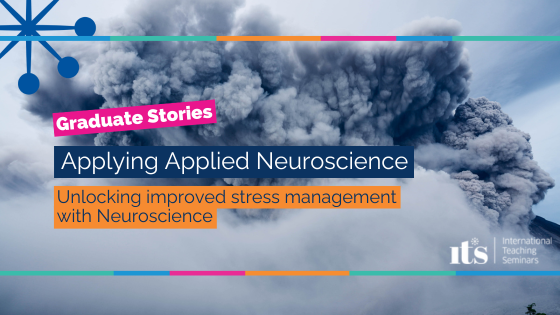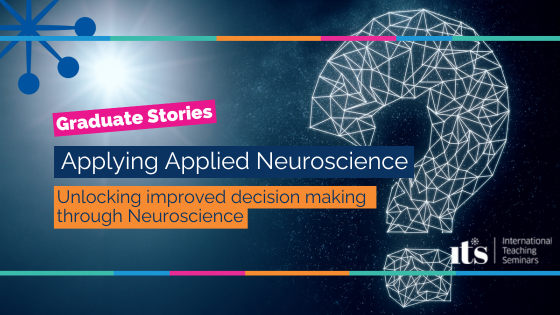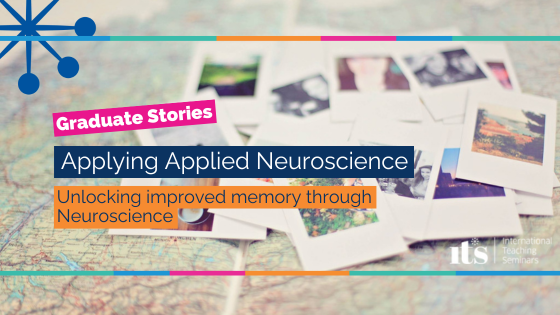Unlocking improved stress management with Neuroscience
Insights from A Graduate’s Journey:
Applying Applied Neuroscience for stress management.
In today’s fast-paced world, stress has become a ubiquitous companion in our personal and professional lives.
The universal experience of stress, with its intricate web of psychological and physiological responses, often leaves many seeking effective coping mechanisms.
Tom, a graduate of our Applied Neuroscience programme, is no stranger to this challenge. Armed with knowledge from his studies, he embarked on a practical journey to apply these insights to his own life.
His story is not just a testament to personal growth but also an exemplar of how Applied Neuroscience can offer tangible solutions in managing the complexities of stress.
This blog post delves into Tom’s application of neuroscience-based strategies, showcasing how an informed understanding of stress can lead to meaningful change and improved well-being.
Read more about Tom’s story below.
Identifying the Problem
Tom faced heightened sensitivity to stress, often leading to severe anxiety, especially in his professional environment. His history of depression, coupled with low self-esteem and a tendency to be overly critical of himself, exacerbated his stress responses.
Early morning rumination was disturbing his sleep, further impacting his ability to cope.
Aim of the Intervention
The intervention aimed to help Tom improve his responses to stressful situations. By enhancing his understanding of how stress leads to anxiety and potentially depression, Tom sought to build resilience and regulate his emotional reactions more effectively.
Applying Applied Neuroscience for stress management
Method Used
Tom’s approach in his intervention was methodical, with each step specifically designed to engage different parts of the brain for effective stress management:
#1 Understanding Stress and Its Effects: Tom started by differentiating between positive and negative stress, employing Tabibnia’s model for resilience, developed by Dr. Golnaz Tabibnia. This model involves the dorsolateral prefrontal cortex (dlPFC), essential for executive functions like planning and decision-making, and the temporal lobe, which is crucial for processing sensory input and forming memories. This helped Tom understand stress from a neurological standpoint.
#2 Reframing Stress Perception: Next, Tom worked on reframing his perception of stress as beneficial. This shift targeted the ventromedial prefrontal cortex (vmPFC), involved in risk and decision making, and the orbitofrontal cortex (OFC), which plays a role in impulse control and reward-based learning. His dlPFC aided in understanding the logic behind this reframing.
#3 Stress as a Thermostat: Tom then explored the concept of allostatic load, using a thermostat metaphor to comprehend stress regulation. This metaphor engaged the precuneus (PC), a part of the brain involved in episodic memory and self-processing, fostering a deeper understanding of how stress affects the brain.
#4 Eustress vs. Distress: Analysing the relationship between stress intensity and performance, Tom activated the dorsolateral prefrontal cortex and precuneus. These brain areas are involved in memory and understanding complex associations, helping him distinguish between eustress and distress.
#5 Calibrating Emotional Responses: Focusing on altering emotional responses, Tom transitioned from amygdala-driven reactions, which are associated with emotional responses, to self-regulation mechanisms in the ventromedial prefrontal cortex and anterior cingulate cortex (ACC), both crucial for regulating emotional responses and decision-making.
#6 Developing Self-Empathy: In this phase, Tom focused on increasing activity in the vmPFC, associated with emotional regulation, while reducing responses in the amygdala, known for its role in fear and stress reactions. This process of fostering self-empathy normalised the challenge of self-directed kindness.
#7 Changing Emotion to Change Behavior: Tom learned to use body language, like smiling and power poses, to influence his emotional state, affecting activities in the amygdala (involved in processing emotions) and the vmPFC (central to processing risk and fear).
#8 Differentiating Reflection from Rumination: Breaking the cycle of rumination involved switching from the Default Mode Network (DMN) to the Cognitive Executive Network (CEN) via the salience network. This switch utilised the dlPFC, key in managing habits and executive functions.
#9 Sleep Neuroscience: Lastly, Tom delved into the neuroscience of sleep, focusing on how self-identity and normalising sleep patterns can enhance sleep quality. This part of the intervention engaged the vmPFC, dlPFC, and precuneus, all of which play roles in sleep regulation and the formation of sleep-related behaviors.
Overall Purpose
The primary goal of Tom’s intervention was to stimulate the salience network to encourage more frequent transitions to the Cognitive Executive Network. This shift was intended to improve self-regulation and reduce the focus on external behaviors, driven by the anterior cingulate cortex which plays a key role in emotional and cognitive processing.
Key Learning and Results for Stress Management
- Influence of Perception on Stress: Tom realised that stress is often a perception based on past experiences, and he learned that he could influence his response to it.
- Emotional Labeling and Story Reframing: Labeling emotions and reframing negative perceptions into positive stories emerged as crucial techniques for stress reduction.
- Physical Responses and Self-Empathy: Tom recognised the importance of smiling and practicing self-empathy to improve his self-perception.
- Implementing Meditation: He decided to restart meditation exercises, understanding their scientifically proven positive impact on stress management.
- Managing Rumination: Tom identified that taking small actions or steps could effectively stop rumination and manage stress by focusing on immediate tasks.
In Conclusion
Tom’s intervention exemplifies a well-rounded, neuroscience-informed approach to managing stress.
His journey highlights the significance of understanding the brain’s role in stress perception and response. Through this intervention, Tom not only gained valuable insights into stress management but also developed practical strategies that he can apply in his daily life, leading to improved well-being and effectiveness both at work and in personal scenarios.
If you want to learn more about Applying Applied Neuroscience and to develop your own intervention to promote better stress management, then see more information about our programme here >
*Tom is a pseudonym.





Leave A Comment